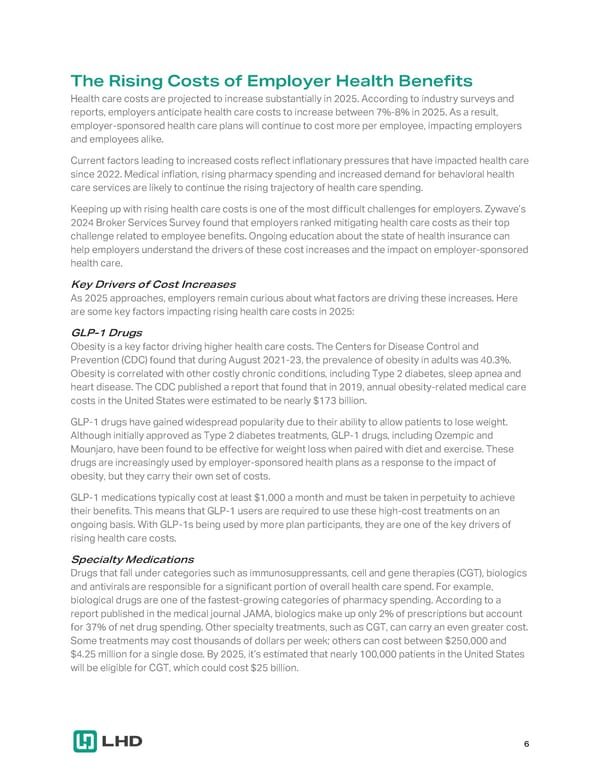The Rising Costs of Employer Health Benefits Health care costs are projected to increase substantially in 2025. According to industry surveys and reports, employers anticipate health care costs to increase between 7%-8% in 2025. As a result, employer-sponsored health care plans will continue to cost more per employee, impacting employers and employees alike. Current factors leading to increased costs reflect inflationary pressures that have impacted health care since 2022. Medical inflation, rising pharmacy spending and increased demand for behavioral health care services are likely to continue the rising trajectory of health care spending. Keeping up with rising health care costs is one of the most difficult challenges for employers. Zywave’s 2024 Broker Services Survey found that employers ranked mitigating health care costs as their top challenge related to employee benefits. Ongoing education about the state of health insurance can help employers understand the drivers of these cost increases and the impact on employer-sponsored health care. Key Drivers of Cost Increases As 2025 approaches, employers remain curious about what factors are driving these increases. Here are some key factors impacting rising health care costs in 2025: GLP-1 Drugs Obesity is a key factor driving higher health care costs. The Centers for Disease Control and Prevention (CDC) found that during August 2021-23, the prevalence of obesity in adults was 40.3%. Obesity is correlated with other costly chronic conditions, including Type 2 diabetes, sleep apnea and heart disease. The CDC published a report that found that in 2019, annual obesity-related medical care costs in the United States were estimated to be nearly $173 billion. GLP-1 drugs have gained widespread popularity due to their ability to allow patients to lose weight. Although initially approved as Type 2 diabetes treatments, GLP-1 drugs, including Ozempic and Mounjaro, have been found to be effective for weight loss when paired with diet and exercise. These drugs are increasingly used by employer-sponsored health plans as a response to the impact of obesity, but they carry their own set of costs. GLP-1 medications typically cost at least $1,000 a month and must be taken in perpetuity to achieve their benefits. This means that GLP-1 users are required to use these high-cost treatments on an ongoing basis. With GLP-1s being used by more plan participants, they are one of the key drivers of rising health care costs. Specialty Medications Drugs that fall under categories such as immunosuppressants, cell and gene therapies (CGT), biologics and antivirals are responsible for a significant portion of overall health care spend. For example, biological drugs are one of the fastest-growing categories of pharmacy spending. According to a report published in the medical journal JAMA, biologics make up only 2% of prescriptions but account for 37% of net drug spending. Other specialty treatments, such as CGT, can carry an even greater cost. Some treatments may cost thousands of dollars per week; others can cost between $250,000 and $4.25 million for a single dose. By 2025, it’s estimated that nearly 100,000 patients in the United States will be eligible for CGT, which could cost $25 billion. 6
 2025 Employee Benefits Market Outlook Page 5 Page 7
2025 Employee Benefits Market Outlook Page 5 Page 7